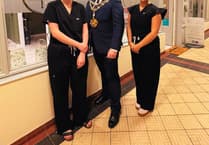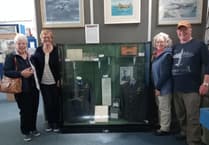The next meeting of Narberth and District Probus Club takes place on June 26 when the guest speaker, Ian Summers, will talk about ‘Hidden India’.
At the most recent meeting, President Patrick Jones was pleased to welcome his counterpart, Roland Edwards, President of Pembroke Probus Club as a guest. Peter Fielding was guest speaker, and he talked about the famous battle at Rorke’s Drift.
Peter has lived in various parts of England during his working life as an engineer with Marconi, Phillips and Cable and Wireless, fixing equipment systems and later with the civil aviation authority. He now lives with his wife, Jane, in Garnant near Ammanford. Peter has visited Rorke’s Drift on two occasions and has researched the battle for many years.
The confrontation took place on January 22, 1879 at a time when British Colonial Victorian policy was at its highest.
During British occupation of South Africa, there had been many insurrections by Zulus but all were repulsed by the British. Nevertheless British occupation continued to be opposed by the indigenous population. In December 1878 lord Caernarvon, Secretary of State for the Colonies, issued an ultimatum to the Zulus to disband and accept British control. The date passed and by January 22 1879 the conflict had expanded, climaxing in the brutal battle of Isandlwana where the British Armoy was virtually annihilated by 20,000 Zulus.
Nearing the end of the conflict, about 4000 Zulus headed for Rorke's Drift, a small Mission Station and hospital a few miles away. The mission was occupied by about 159 soldiers and civilians of whom eight were patients in the hospital.
Peter described the heroic actions of two soldiers in particular, Henry Hook and John Williams, who were defending the patients, There are various accounts but, in essence, the hospital consisted of three rooms each with an external door but with no interconnecting doors. So whilst Private Hook repulsed the Zulus trying to enter the external door, John Williams attacked a wall, making a hole big enough to allow access to the adjoining room, pulling several patients with him. The two men swapped roles with Williams at the door and Hook at the next wall. They made amazing progress and ended up in the compound where some more troops provided protection for the two men and eight patients.
Peter was able to show photographs of groups of soldiers including private Hook and John Williams. It came as a great surprise when Peter, showing a head and shoulders picture of John Williams, revealed that John Williams was, in fact, his great grandfather. His real name was John Fielding but for some unknown reason John Fielding had changed his name to Williams when he joined the Army. He and Hook were among 11 people who were awarded Victoria Crosses for their brave actions on that day.
Overnight, the battle ceased and next morning, much to the relief and surprise of the inhabitants of Rorke's Drift, the Zulus had disappeared.
John Williams served in the army until 1883 when he was transferred to the reserves. He returned to Cwmbran and died in 1932 and was buried in Llantarman. A pub and a Nursing Home was named in his honour.
John Williams's Victoria Cross was donated to the South Wales Borderers Museum by the Fielding family and is displayed at the Royal Welsh Regimental Museum in Brecon, Powys.
If you would like to join Narberth Probus Club for the meeting on June 26, call Patrick Jones on 07846 660904.





Comments
This article has no comments yet. Be the first to leave a comment.